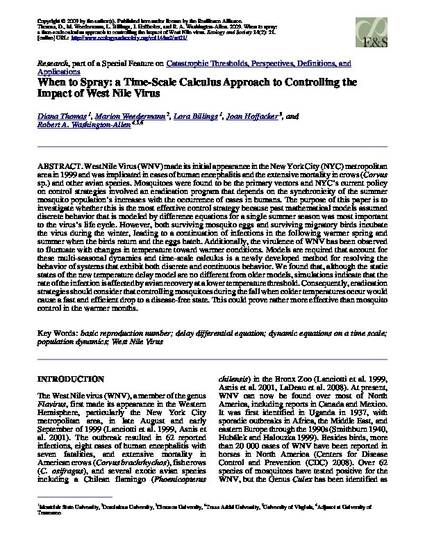
Article
When to Spray: a Time-Scale Calculus Approach to Controlling the Impact of West Nile Virus
Ecology and Society
(2009)
Abstract
West Nile Virus (WNV) made its initial appearance in the New York City (NYC) metropolitan area in 1999 and was implicated in cases of human encephalitis and the extensive mortality in crows (Corvus sp.) and other avian species. Mosquitoes were found to be the primary vectors and NYC’s current policy on control strategies involved an eradication program that depends on the synchronicity of the summer mosquito population’s increases with the occurrence of cases in humans. The purpose of this paper is to investigate whether this is the most effective control strategy because past mathematical models assumed discrete behavior that is modeled by difference equations for a single summer season was most important to the virus’s life cycle. However, both surviving mosquito eggs and surviving migratory birds incubate the virus during the winter, leading to a continuation of infections in the following warmer spring and summer when the birds return and the eggs hatch. Additionally, the virulence of WNV has been observed to fluctuate with changes in temperature toward warmer conditions. Models are required that account for these multi-seasonal dynamics and time-scale calculus is a newly developed method for resolving the behavior of systems that exhibit both discrete and continuous behavior. We found that, although the static states of the new temperature delay model are no different from older models, simulations indicate that the rate of the infection is affected by avian recovery at a lower temperature threshold. Consequently, eradication strategies should consider that controlling mosquitoes during the fall when colder temperatures occur would cause a fast and efficient drop to a disease-free state. This could prove rather more effective than mosquito control in the warmer months.
Keywords
- basic reproduction number,
- delay differential equation,
- delay equations on a time scale,
- population dynamics,
- West Nile Virus
Disciplines
Publication Date
2009
Citation Information
Diana Thomas, Marion Weedermann, Lora Billings, Joan Hoffacker, et al.. "When to Spray: a Time-Scale Calculus Approach to Controlling the Impact of West Nile Virus" Ecology and Society Vol. 14 Iss. 21 (2009) Available at: http://works.bepress.com/lora-billings/14/
